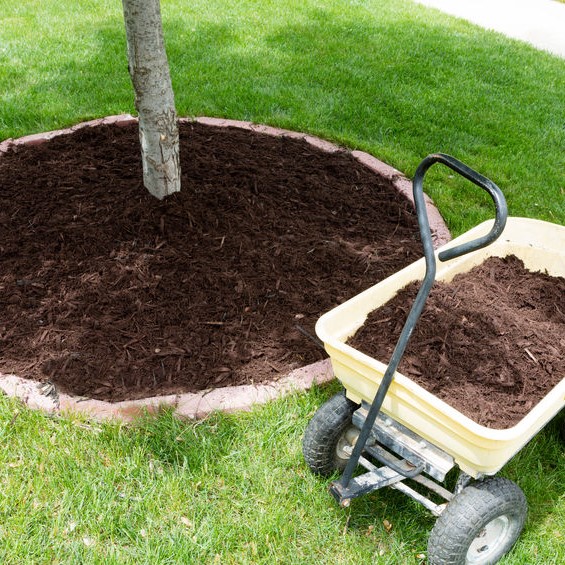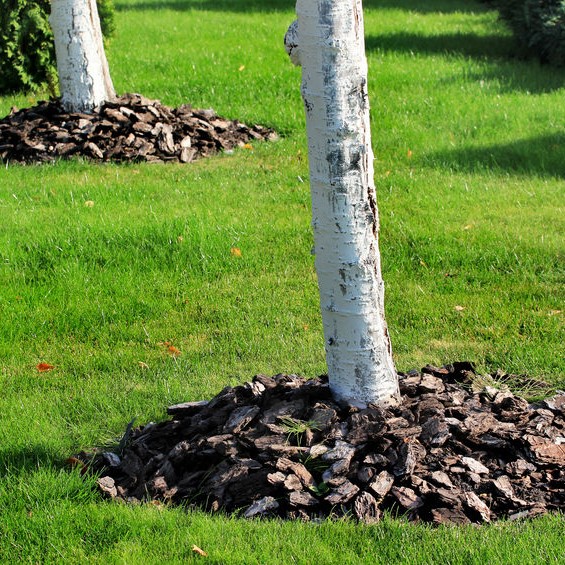
What is the purpose of using tree mulch?
Is tree mulch for decorative purposes? Or is it a protective layer that offer nutrition too? There is a lot said about tree mulch, and that brings a lot of questions to surface. Some of those we’ll be answering here in our piece today. Questions like, should trees be mulched?
Well, there are many do’s and don’ts about tree mulch around trees, and the biggest “don’t” is not to create too big of a ‘mulch volcano’. What is a mulch volcano? This is an industry description when an excessive amount of mulch is placed around a tree.
A young tree with mulch around it in a circular fashion that starts out wide and gets closer to the tree as it goes upward. It eventually takes on a volcano shape with a tree coming out of the center. The concern is for younger trees when a volcano is created with either dirt or tree mulch because:
- Water runs away from the tree base where it is needed and down the sides of the volcano.
- A volcano deeper than six inches holds the water, keeping it from a young tree’s roots.
- Disproportionate tree mulching suffocate the tree roots.
- Deep mulch invites diseases and rodents.
Are you supposed to remove old mulch?
No, it isn’t necessary according to gardening and tree experts. Eventually, tree mulch breaks down and adds nutrients to the soil. Unless you just like the work, keep the old tree mulch in place and simply add enough new tree mulch to give you approximately a two inch depth.
Tree mulch will mat together sometimes, which impede the rain and sunlight from getting to the roots under the soil. Simply fluff up the old tree mulch with a rake and add some new mulch on top. The only exception to this is when there is fungus or mold growing on the old mulch. In that case, remove the old and apply all new tree mulch.
What should I do with old mulch?
You can still use old mulch, even if you determine that it hasn’t decomposed in an appreciable fashion. Simply rake the old tree mulch to the side for now and continue with your gardening and planting. If you have excess amounts of old mulch, shovel it into a wheelbarrow and save it, it can be use soon for a flower or vegetable garden.
Now, apply your compost to your annual flower or vegetable garden, working it into the soil. bed or annual flower bed, and till it under or work it into the soil with a spade. Now return the old tree mulch to the planting beds, spreading evenly and adding new mulch to get a 2 to 3 inch thickness.
If that old tree mulch has decomposed considerably, work it into the soil, tilling it, and let the organic nature of it become a soil amendment with the compost. Then add your new tree mulch accordingly.
How often should you mulch your trees?
For slow draining soil, you don’t need any more than two inches of tree mulch. If using an organic tree mulch, like ground or shredded bark, compost, cottonseed hulls, pine straw, or wood chips, these break down and will need to be replenished twice a year.
What should I put down before mulching?
Some homeowners that add tree mulch in gardens will put down a geotextile or plastic before adding the tree mulch. Experts tend to argue this practice, some saying that it creates water runoff that takes away the clean and streamline look of a garden. If you’re using an organic tree mulch that breaks down, landscape fabric will keep the mulch from contacting the soil, taking away its ability to become healthier and improved.
Contrary to popular belief, weeds will grow into that landscape fabric. For aesthetic purposes, laying a fabric or plastic down first, when the tree mulch sifts, or as it thins out, that fabric or plastic will show
through, taking away from the aesthetics of the garden.

Can you turn tree trimmings to mulch?
Absolutely! What better way to recycle, right? Collect any tree bark, branches, or pruned trimmings and with gloves and safety glasses on, put them all into a woodchipper. Mix with natural leaf mulch that is created naturally and you’ll have an organic tree mulch! If you don’t own a woodchipper, you can rent them from your local big box home improvement stores for a weekend.
Is there a difference between tree mulch and compost? Yes, and the differences are significant, making it important that you use both correctly. Compost is made from decomposed, organic materials and adds nutrients to the soil that improve the structure. Mulch comes in organic or inorganic materials that aren’t decomposed and is should be used to limit weed growth, prevent erosion, and retain soil moisture. Is your tree in need of mulch in Fort Worth, TX? Call (817) 717-7737 today.
